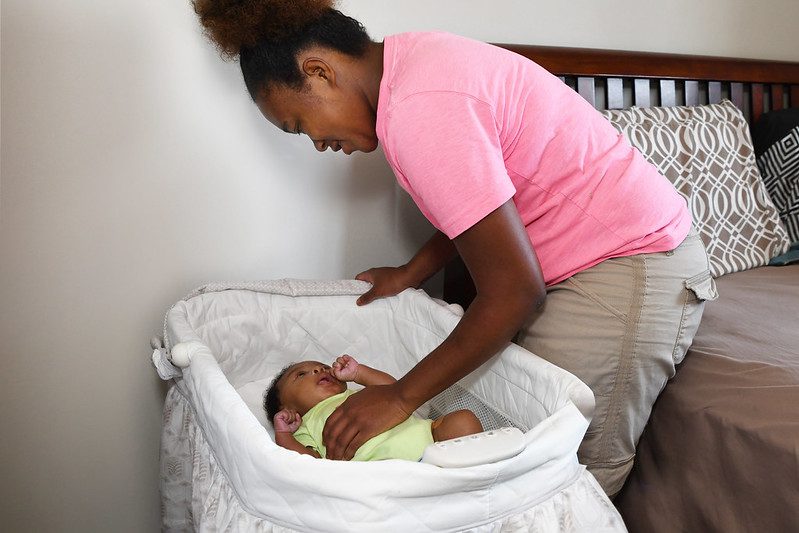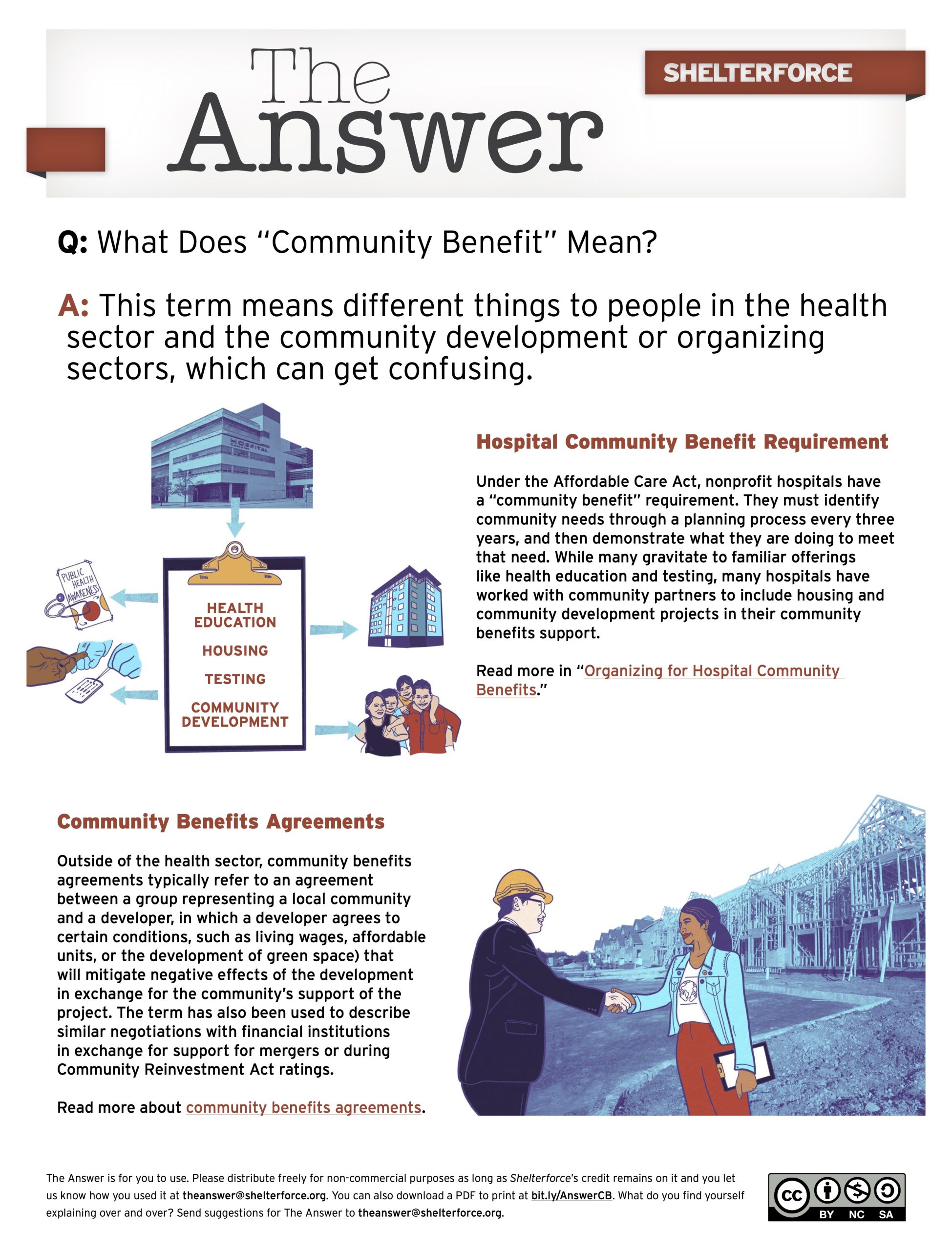
Photo courtesy of National Institute of Child Health and Development, via Flickr, CC BY-NC-ND 2.0
Finding solutions to the maternal and infant mortality crisis can be a confounding task. Are more mothers and babies dying because they lack insurance coverage and don’t have access to good health care providers? Are racial disparities to blame for the fact that Black mothers are dying at three or four times the rate of white mothers? The answers are yes and yes, plus more. Advocates, legislators, health providers, and health care experts alike find themselves scrambling for a solution.
One piece of the puzzle that may have been overlooked before now is access to stable, safe, and affordable housing.
When Housing Insecurity and Maternal Health Intersect
The links between health outcomes and housing are well-documented. Housing insecurity negatively affects a person’s health. Along with the stress it causes, it also interferes with regular health care—both preventive care and treatment for acute medical conditions. Since poor maternal health can lead to poor perinatal outcomes, it’s no surprise that housing problems can adversely affect birth outcomes. In 2021, JAMA Pediatrics published a study that examined the connection between evictions and birth outcomes. After reviewing the birth records of infants born to mothers who were evicted in Georgia from Jan. 1, 2000, to Dec. 31, 2016, the study’s authors found that evictions during pregnancy were associated with prematurity and low birth weight. The American College of Obstetricians and Gynecologists (ACOG) concurs. In a statement issued in 2010 and reaffirmed in 2021, ACOG’s Committee on Health Care for Underserved Women warned that homeless women have higher rates of preterm delivery.
A study published in Health Affairs looked at the effect of homelessness on pregnant persons. Among the findings were that women experiencing homelessness were more than twice as likely to experience a health complication during labor and delivery. They also found that women living in shelters were at greater risk for hemorrhaging and other health complications.
Since there are notable racial disparities in homelessness, this might be one contributor to the racial disparities in birth outcomes.
Federal Housing Laws vs. Local Landlords
While it’s particularly important for people to have stable housing during pregnancy, discrimination often means that they instead face added challenges securing a place to live.
Federal housing laws, including the Fair Housing Act, prohibit discrimination based on familial status. This includes pregnant persons and families with children under the age of 18. But according to Cashauna Hill, attorney and executive director of the Louisiana Fair Housing Action Center, that doesn’t stop property owners from finding ways around renting spaces to pregnant persons and people with children. They use wording such as “adults only” or “occupancy limits” to discourage pregnant people or people with children from applying to rent a unit. They also sometimes cite issues with the property—like the unit has too many stairs, or it has lead paint—as a way of dissuading parents of small children from applying to rent the property.
In many cases, parents experiencing housing discrimination may not be aware of the laws that protect them. And even if they are aware, they may not have the time or resources to pursue the case. Disregard for the law by property managers can and has led to litigation where the U.S. Department of Housing and Urban Development has had to sue property owners.
Hill says that discrimination can sometimes come from ignorance about the law. “The lack of knowledge and information [about fair housing laws] is an ongoing problem. We still continue to see providers who believe that if renters have children, then they can’t live on the central [ground] floor of a building. It’s illegal to deny full access to someone because of the fact that they have children. So, there’s a lack of clarity.”
On the other hand, says Hill, “some property owners are clear about what the federal fair housing laws are but still choose to disregard them when it comes to familial status because they think they won’t get caught. Or we have property owners that will be like ‘well you can just sue me because I made this decision based on safety.’ That is not an allowable [excuse].”
Healthy Beginnings: A Case Study
Could addressing housing instability and homelessness through rental support and other social services be the key to lowering infant mortality rates that result from such instability? A nonprofit organization in Ohio tested that theory in a pilot program that addressed housing issues among expectant people.
Healthy Beginnings At Home, which launched in 2018 in Columbus and ran for 18 months, provided rental assistance and housing stabilization services to unstably housed pregnant women living in Ohio. The program was intended to address the high infant mortality rates among people of color, says Marcus Roth, communications/development director of the Coalition on Homelessness and Housing in Ohio.
“Ohio had one of the worst rates of infant mortality for years,” Roth says. “And the disparity between people of color and white residents was very large.” In 2019, Black infants in Ohio were 2.8 times more likely to die before their first birthday than white infants, according to the Ohio Department of Health’s 2019 Infant Mortality Annual Report.
“People who are couch surfing or living in a shelter or in a car are more likely to have poor birth outcomes from stress and all the other problems that come with housing instability,” Roth says.
One hundred pregnant women experiencing homelessness were selected for the program, which was implemented by CelebrateOne, a Columbus-based infant mortality prevention collaborative, and supported by partnerships with Home for Families, the Columbus Metropolitan Housing Authority, and Care Source—Ohio’s Medicaid program.
Half of the women in the program were placed in an intervention group while the other half were placed in a control group. “All of the women [in both groups] were offered what we refer to as ‘usual care,’” explains Amy Riegel, former senior director of housing for Care Source, “but it wasn’t required that they use it. They were offered care coordination or Medicaid benefits through their managed care organization [Care Source], life coaches, mom support groups, lactation support, home visiting, and WIC.”
But those in the intervention group got two additional things: they received 100 percent rental assistance for 9 months, followed by a six-month step-down period where they would pay a little more of their own money toward rent each month. They also worked with a housing stabilization specialist who helped them clear up debts, locate housing, complete applications, assist with landlord disputes, renegotiate leases, and other issues.
“The study showed very promising trends,” says Riegel. According to the results, 40 of the 51 babies in the group that received housing supports were born full-term at healthy weights compared to just 24 of 44 babies in the control group. Four fetal deaths occurred in the usual care group, while none were reported in the housing intervention group. (Two women in the control group dropped out of the study.) Babies born to women who received rental assistance were 60 percent less likely to require a stay in the neonatal intensive care unit (NICU) after birth than those in the usual care group. For the babies who did spend time in NICU and whose parents received rental assistance, the length of their stay was significantly lower; averaging 8 days versus 29 days for babies born to parents in the control group.
Now the collaborative wants to expand the program to Dayton, Akron, and Cincinnati. They are asking the Ohio legislature to invest $9 million from American Rescue Plan funds to make it happen.
[RELATED ARTICLE: COVID-Relief Funds Filling Some Housing Budget Gaps]
“Currently Medicaid programs are not allowed to pay rent,” Riegel says. “We’re hoping that the research will show the importance of blending these funding sources together so that when an organization is looking at health, they can’t just look at what prescriptions can be provided or what health services can be provided. Sometimes it’s about paying the rent or buying groceries or paying for transportation to get where you need to go. Those things can have a significant impact on health.”
Solutions in the Making
When a pregnant person needs help paying for basic necessities, like food, health insurance, or housing, they may reach out to several different agencies for help. Do the agencies ever connect with one another to assure they are providing optimum and complete assistance? Could something possibly fall through the cracks because the data systems are not aligned?
In 2019, The Pew Charitable Trusts created the Calling All Sectors Initiative (CASI), a Cross Sectors Partnerships for Health Project. The project created cross-sector “core teams” in each state that are composed of health care providers, community advocates, and state government agencies. Their purpose is to collaboratively “address drivers of maternal and infant health issues, including housing.”
The project distributed two-year grants to nine states and the District of Columbia. The grants allowed for the creation of multi-agency teams representing health care systems, community-based organizations, and state agencies. “Our focus with these teams was on housing and health policy to address the really upstream factors affecting maternal and infant health,” says Maura Dwyer, senior manager for the Health Impact Project at The Pew Charitable Trusts. “We work to change the environmental and social factors. And to do that we need to work with people who work in those sectors.”
[Related Article: Connecting the City’s Social Services to Help At-Risk Populations]
Minnesota’s team is taking a deeper dive into how to create comprehensive programs that will address housing and its connection to infant health issues. The team performed a data mapping process and identified government agencies that have provided assistance to a given individual or family, and inequities within agencies. The team identified gaps in services, and opportunities for addressing those gaps.
Helen Jackson Lockett-El, community engagement planner at the Center for Health Equity at the Minnesota Department of Health, worked as the project coordinator for CASI in Minnesota. Various state government agencies met several times and discussed the data and the population they served. Together the agencies hosted community discussions to hear from the public about their experiences dealing with the system as they sought benefits. “What we found out was that the people felt like they were being treated less than when they applied for benefits,” describes Jackson Lockett-El.
For example, she says, “When they finally got an appointment to see a case worker, the worker would ask the women who were applying for benefits for a case number or other information. If they didn’t have it, the case worker would just send them back [to another agency]. Then they would have to start all over again. The women said it felt punitive.”
This learning collaborative has been insightful and helpful, she says. “This was a great opportunity for people to . . . focus together on how we could work together to change the experience of those experiencing homelessness.”
Progress and positive results do not have to be restricted to just Minnesota and Columbus. These two cities are examples of how listening to the needs of disenfranchised residents and investing in housing and social supports can create a more cohesive, responsive local government and improve health outcomes for birthing persons and infants.




Comments